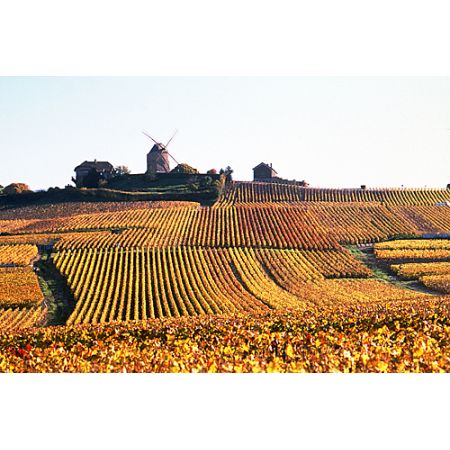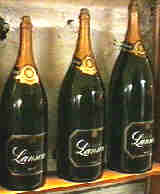Process of Champagne Production:
Harvesting
 The juice of most
grapes is white so the colour of the wine comes only from the skins.
Usually a blend of the juice of white and black grapes is used to make
champagne. Blancs de Blanc are the only examples made purely from white
grape. Rose, or pink, champagnes are produced by using some red skins
as well as the white. The black and white grapes are grown in separate
vineyards throughout the region. For example, some black grapes are
grown on the slopes of the Montagne de Reims - a hill to the south-west
of Reims with its southern point at Epernay - and some white grapes come
from the Cotes des Blancs, south of Epernay. There are also extensive vineyards
in the valley of the River Marne, downstream of Epernay. Only Blancs de
Blanc are made from white grapes only.
The juice of most
grapes is white so the colour of the wine comes only from the skins.
Usually a blend of the juice of white and black grapes is used to make
champagne. Blancs de Blanc are the only examples made purely from white
grape. Rose, or pink, champagnes are produced by using some red skins
as well as the white. The black and white grapes are grown in separate
vineyards throughout the region. For example, some black grapes are
grown on the slopes of the Montagne de Reims - a hill to the south-west
of Reims with its southern point at Epernay - and some white grapes come
from the Cotes des Blancs, south of Epernay. There are also extensive vineyards
in the valley of the River Marne, downstream of Epernay. Only Blancs de
Blanc are made from white grapes only.
There is a wide variation from year to year in the
quality of the grapes, and hence the wine, that are produced because
the vineyards are so far north and the weather is not consistent.
The best Champagnes are 'vintage', i.e. made almost entirely from wines
of one good year; non vintage Champagnes are a blend of good and
not so good wines.
Pressing
After they have been harvested the grapes are pressed. Whole grapes
are loaded gently into enormous presses and, slowly, the juice is
extracted. This occurs three or four times and each time more tannin and
colour comes out of the skins, although the actual skins and pulp have
to be removed.
First
Fermentation

Fermentation takes
place in stainless steel cylinders or barrels; where yeast is added to
the grape juice so fermentation can occur. Separate blocks are kept
for each vineyard. The yeast feeds on the sugar in the grape juice and
releases alcohol (as ethanol), heat and carbon dioxide. In this first fermentation,
the CO2 is not important, so it is released via valves in the
tanks.
Home
Next Stages

 The juice of most
grapes is white so the colour of the wine comes only from the skins.
Usually a blend of the juice of white and black grapes is used to make
champagne. Blancs de Blanc are the only examples made purely from white
grape. Rose, or pink, champagnes are produced by using some red skins
as well as the white. The black and white grapes are grown in separate
vineyards throughout the region. For example, some black grapes are
grown on the slopes of the Montagne de Reims - a hill to the south-west
of Reims with its southern point at Epernay - and some white grapes come
from the Cotes des Blancs, south of Epernay. There are also extensive vineyards
in the valley of the River Marne, downstream of Epernay. Only Blancs de
Blanc are made from white grapes only.
The juice of most
grapes is white so the colour of the wine comes only from the skins.
Usually a blend of the juice of white and black grapes is used to make
champagne. Blancs de Blanc are the only examples made purely from white
grape. Rose, or pink, champagnes are produced by using some red skins
as well as the white. The black and white grapes are grown in separate
vineyards throughout the region. For example, some black grapes are
grown on the slopes of the Montagne de Reims - a hill to the south-west
of Reims with its southern point at Epernay - and some white grapes come
from the Cotes des Blancs, south of Epernay. There are also extensive vineyards
in the valley of the River Marne, downstream of Epernay. Only Blancs de
Blanc are made from white grapes only.